Last year a graduate student in musicology at the University of Connecticut took an independent study with me on the music of Maurice Ravel. While in the end his work was insightful and successful, he was quite frustrated and discouraged at the beginning and even the middle stages. In analyzing the so-called "character dances" from the ballet Daphnis and Chloe composed 1909-12,1 he typically would come in with a harmonic reduction or bass-line sketch or form chart of a scene and go through it with me. Following this, his comment would usually be some variation on "I did all this stuff, but I'm not sure what it all means and where to go from here." In trying to help him formulate a viable approach, I found myself returning repeatedly to two sources: to Ravel's own commentary on his music; and to the opening gestures of the piece, or, more specifically, what I shall call its compositional premise. As my student began to consider Ravel's writings in relation to the music, his analyses of the different dances began to take shape. They did not hew to a single methodology or perspective, but rather displayed a broad and flexible array of strategies and graphic examples, including modified Schenkerian analysis, octatonic and hexatonic partitioning, parsimonious voice leading, and referential bass-line scale collections.
My essay shall explore a very simple idea: that a composer's technical commentary on his or her composition may not only be useful to the analyst, but may also bring together in a fruitful way what I term "compositional premise" and analysis. (This shall be elaborated below.) Of course composers may also say non-useful or even ludicrous things about their music for any number of reasons. Indeed, one of my colleagues comes right out and instructs his students straightaway, in writing their history papers, to ignore what the composer says! In countering this claim, one can point to a number of theorists whose analyses are enhanced by sensitive consideration of a composer's musical thinking, either as expressed in sketches (Carl Schachter on Beethoven), or in words (Steve Larson on Bill Evans).2 Moreover, even when a composer's words mislead rather than lead, I suggest that they remain potentially useful to the analyst, to the extent that they pose fundamental questions that otherwise would not surface.
For Ravel, the compositional premise for a given work is generally bound up with a musical event—motive, harmonic progression, dissonant sonority, and so forth—whose context creates or reveals some kind of compositional problem to be solved.3 This is not original with Ravel: for Ravel, along with several generations of French writers and composers, the influence of Edgar Allen Poe looms large, in particular the essay The Philosophy of Composition, in which Poe explains in step-by-step terms the problems and solutions he set for himself in the composition of his most famous poem The Raven.4,5 (Ravel goes on to say that Poe's essay was the most important influence on his development as a composer.)
A striking example of compositional premise-as-problem occurs in the song "Surgi de la croupe et du bond" from Ravel's Trois Poèmes de Stéphane Mallarmé. The song opens with a string pizzicato which, given its register, texture and timbre, is virtually indeterminate in pitch without the aid of a score. This initial condition of indeterminacy provides a musical premise precisely isomorphic to Mallarmé's notoriously difficult poem, which in some sense is about the paradox of a poet's inability to create, this very inability then becoming transformed into the remote possibility of creation. A more concrete premise is what might be called a "case of mistaken identity." In the opening of the "Blues" movement from the Sonata for Violin and Piano, the violin in banjo style strums a I-IV-V progression in G major, whose tonal authority is brazenly undermined by the piano's entrance on a bass  . Still another is the tonal neutrality of the pentatonic collection, which is used for very different structural and representational ends in "Soupir," the first of the Mallarmé songs, and in the opera L'Enfant et les sortilèges.
. Still another is the tonal neutrality of the pentatonic collection, which is used for very different structural and representational ends in "Soupir," the first of the Mallarmé songs, and in the opera L'Enfant et les sortilèges.
With respect to analysis as well as the pedagogy of analysis, I suggest that thinking along these lines can help structure the analytical process, especially for music of the early twentieth century that exhibits such a wide range of techniques. The problem remains, however, of precisely how to bridge the potential gap between compositional premise and analytical methodology.
To this end, we shall look at three examples taken from Ravel's music: two from the piano cycle Valses nobles et sentimentales, one from the song "Rêves" (Dreams). We shall see that Ravel's words help shape the individual analyses, in one case by revealing a disguised structural feature; in another by simultaneously leading and misleading; and finally, by commenting on another composer's work that directly relates to his own.
Let us turn first to Valses nobles et sentimentales. By way of introduction, Valses nobles was premiered at a concert sponsored by the progressive Société Musicale Indépendante in May of 1911. New works by various composers were identified in the program by title only, and the audience was supposed to guess the composer. Shockingly for Ravel, the performance of his Valses was interrupted by booing and catcalls; even his close friend Cipa Godebski asked him what idiot could have written this piece!6
One can easily imagine what the opening to the first waltz sounded like to French ears circa 1911. (My children actually wince and imitate vomiting noises whenever I play it!) In this context, Ravel's contemporary account of the opening motto takes on added interest (Example 1).
Example 1. Valse noble #1, opening.

In the course of a composition lesson with his student and first biographer Roland-Manuel, the composer states: "The opening two measures . . . consist of a linear progression,  (beats one and two), to
(beats one and two), to  (beat three), to G (prolonged through measure two)."7 This ascending three-note chromatic slide is by no means obvious, given the registral shifts and the merely implied presence of G in an upper voice resolving the
(beat three), to G (prolonged through measure two)."7 This ascending three-note chromatic slide is by no means obvious, given the registral shifts and the merely implied presence of G in an upper voice resolving the  (G only literally occurs as the bass note). Its presence consequently raises a number of questions for interpretation. First is the functional status of the opening sonority. The right-hand tones suggest a dominant thirteenth, with
(G only literally occurs as the bass note). Its presence consequently raises a number of questions for interpretation. First is the functional status of the opening sonority. The right-hand tones suggest a dominant thirteenth, with  delaying the third
delaying the third  ; with the fifths trichord G-D-A in the left hand, however, tonic and dominant implications are superimposed. On beat three, the non-alignment of chord tone and harmonic function continues, as the "proper" tones of the dominant seventh—A, C and D—shift up a semitone to
; with the fifths trichord G-D-A in the left hand, however, tonic and dominant implications are superimposed. On beat three, the non-alignment of chord tone and harmonic function continues, as the "proper" tones of the dominant seventh—A, C and D—shift up a semitone to  ,
,  and
and  . When the fifths trichord is reiterated on the following downbeat, it clearly represents tonic, with the sixth E and ninth A as conventional additions. However, on beat three, assuming that tonic harmony still holds, the same "wrong notes"
. When the fifths trichord is reiterated on the following downbeat, it clearly represents tonic, with the sixth E and ninth A as conventional additions. However, on beat three, assuming that tonic harmony still holds, the same "wrong notes"  and
and  (technically unresolved appoggiaturas) that attended dominant harmony in the previous bar now are part of the tonic. (They may also be considered as leading to B and D on the following downbeat.)
(technically unresolved appoggiaturas) that attended dominant harmony in the previous bar now are part of the tonic. (They may also be considered as leading to B and D on the following downbeat.)
Taking the composer's comment and its tonal ramifications as a point of departure, it is now possible to view the opening as a radically idiosyncratic spin on a simple dominant-to-tonic cadence and thereby reconstruct Ravel's ascending linear progression from the ground up. Example 2 shows this process in seven conceptual stages labeled a-g. (The reader is advised to play through the stages, then listen to the actual opening; this also works as a classroom exercise in harmonic dictation.)
Example 2. Valse noble #1, conceptual stages.
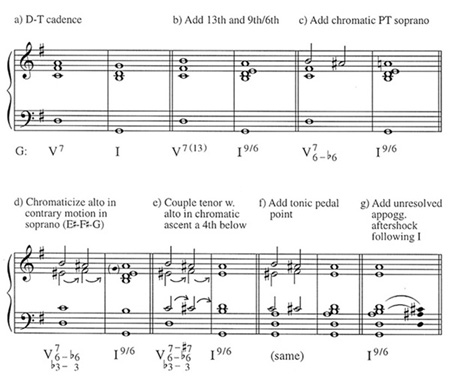
In passing I referred to the Valses nobles as a "piano cycle" as opposed to a mere collection of unrelated movements. This was deliberate. Part of its "cyclehood" lies in the presence of this ascending chromatic slide as a global compositional premise. More precisely, the chromatic motive itself, in conjunction with the retention of common tones across different chord functions—especially the play between tonic and dominant—figures significantly in subsequent movements.
We turn next to the introduction to the second waltz; see Example 3.
Example 3. Valse noble #1, opening.
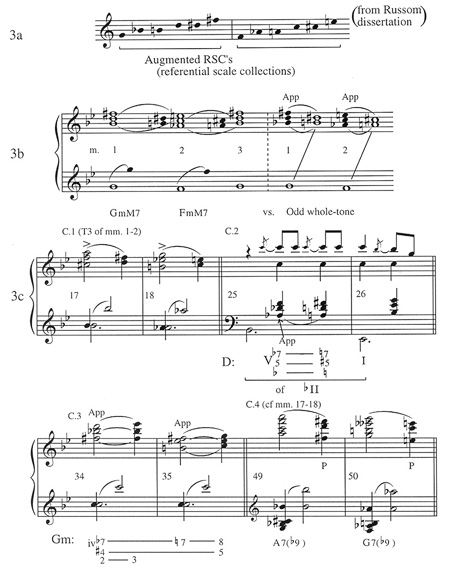

As a point of departure, the top system (3a) displays Philip Russom's reading of the opening two bars, drawn from his illuminating dissertation on Ravel's pre-War music.8 According to Russom, each measure partitions what he terms complementary augmented referential scale collections (also known as set class 6-20 or the hexatonic collection). Because Russom views Ravel's music as fundamentally non-tonal, his analysis focuses on the transpositional relation between bars one and two and their completion of the aggregate. At the same time, such an account does not address the possible relation of these bars to the opening of the first waltz, or the conventional tonal aspects of the phrase as a whole.
Given the augmented triads and resultant whole-tone flavor of the passage, its structural voice leading could be interpreted in several ways. Graph 3b proposes two readings. The first emphasizes the (overlapped) ascending chromatic slide in major thirds in imitation as a variant of the opening of the first waltz.9 In turn, the pattern of imitation stresses the downbeat minor-major seventh chords on G and F. In contrast, the second reading foregrounds a different aspect of the first waltz—the motion from strong beat (bar) dissonance to weak beat (bar) consonance; hence the downbeat sonorities represent appoggiaturas resolving to the weak-beat augmented triads, together comprising the complete odd whole-tone scale.
Significantly, the remainder of the waltz provides evidence that sometimes supports one interpretation of the opening, sometimes the other (3c.1-4). The excerpts labeled c.2 and c.3 clearly support the downbeat-as-appoggiatura reading, the former presenting another instance of the chromatic ascending slide. Excerpt c.1 (mm. 17ff) merely transposes the introduction up a minor third and, taken in itself, provides no supporting evidence one way or the other. Subsequently at mm. 49ff, however (following the reprise beginning m. 41), Ravel subposes a G below the former bass  in a more fully orchestrated version of mm. 17ff. This suggests a new identity for the downbeat sonority as an inverted dominant ninth. While I'm certainly not proposing the first chord of the piece as
in a more fully orchestrated version of mm. 17ff. This suggests a new identity for the downbeat sonority as an inverted dominant ninth. While I'm certainly not proposing the first chord of the piece as  9, I would caution against a definitive reading enshrining the downbeat as an appoggiatura.
9, I would caution against a definitive reading enshrining the downbeat as an appoggiatura.
Indeed, it appears to be part of Ravel's strategy to maximize harmonic and voice-leading contexts for the initial right-hand augmented triad  -D-
-D- . Graph 3d shows this triad as part of the voice-leading configuration for tonic (note the hint of a resolution for the right-hand
. Graph 3d shows this triad as part of the voice-leading configuration for tonic (note the hint of a resolution for the right-hand  5 to G5 as part of the poetic left-hand octave leap), dominant (mm. 7-8) and subdominant (mm. 34-35).10
5 to G5 as part of the poetic left-hand octave leap), dominant (mm. 7-8) and subdominant (mm. 34-35).10
Graph 3e reconsiders the introduction in light of the foregoing discussion and combines elements of the two readings proposed in 3b. Thus the tonic minor-major seventh, elaborated by the chromatic ascending slide to the neighboring F chord, leads to the sustained appoggiatura chord labeled X (mm. 5-6), representing a species of  , though not a conventional harmony on that scale degree. Both X and its motion to the dominant sustain the original augmented triad until the latter's resolution of
, though not a conventional harmony on that scale degree. Both X and its motion to the dominant sustain the original augmented triad until the latter's resolution of  -5 and
-5 and  -3. In sum, this interpretation of the second waltz does not ineluctably issue forth from Ravel's comments on the opening waltz. Rather, the composer's comments become a catalyst to the analyst for consideration of relevant harmonic and voice leading contexts, in this instance for the chromatic slide, appoggiatura gesture, and the augmented triad.
-3. In sum, this interpretation of the second waltz does not ineluctably issue forth from Ravel's comments on the opening waltz. Rather, the composer's comments become a catalyst to the analyst for consideration of relevant harmonic and voice leading contexts, in this instance for the chromatic slide, appoggiatura gesture, and the augmented triad.
The penultimate waltz #7 (which Ravel referred to as the most characteristic of the set)11 further expands the influence of the ascending chromatic slide (Example 4).
Example 4. Valse noble #7, opening.
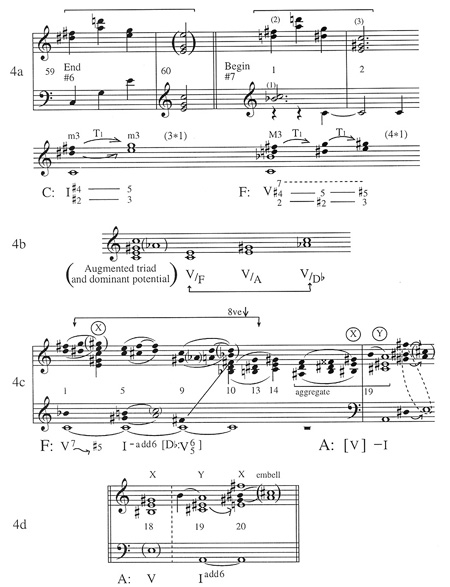
Graph 4a shows the linkage from the cadence concluding the sixth waltz to the opening of the seventh.12 While the melodic gesture is untransposed, the pitch alterations are significant and include:
- the addition of
 as 7th, turning C-as-tonic (
as 7th, turning C-as-tonic ( ) into C-as-V7/F;
) into C-as-V7/F; - the expansion of the sliding neighboring minor third to major third;13
- the extension of the chromatic slide by one more step (consistent with the openings of the first and second waltzes), which leads to the augmented triad C-E-
 implying V7
implying V7 of F.
of F.
Graph 4b shows the other possible dominant contexts of the C augmented triad, which, taken together, complete a major thirds cycle. Interestingly,  is briefly implied in m. 9, beats 1-2; however, V/A, which is revealed as the true V-I function at the end of the introduction and beginning of the waltz proper (mm. 18-19) is the only one of the three dominant possibilities without reinforcement by its seventh.
is briefly implied in m. 9, beats 1-2; however, V/A, which is revealed as the true V-I function at the end of the introduction and beginning of the waltz proper (mm. 18-19) is the only one of the three dominant possibilities without reinforcement by its seventh.
Graph 4c provides a harmonic sketch of the introduction. Its progress may be viewed in three stages. Stage 1 implies the progression V7 to Iadd6 in F major (over the bass pedal point on C). Stage 2 briefly implies
to Iadd6 in F major (over the bass pedal point on C). Stage 2 briefly implies  , then leads to the ascending chromatic slide (now expanded from major third to full augmented triad) down an octave from the opening; as a result, C4 loses its status as bass pedal. Finally, the augmented triad slide is enharmonically respelled, consistent with its resolution to A major. (Note that the resolution as V-I in A coincides with the ascent to another augmented triad
, then leads to the ascending chromatic slide (now expanded from major third to full augmented triad) down an octave from the opening; as a result, C4 loses its status as bass pedal. Finally, the augmented triad slide is enharmonically respelled, consistent with its resolution to A major. (Note that the resolution as V-I in A coincides with the ascent to another augmented triad  -
- -A (designated as y), which together with the preceding slide completes the aggregate.)
-A (designated as y), which together with the preceding slide completes the aggregate.)
Graph 4d shows a further twist in the voice leading from the introduction to the beginning of the waltz proper. That is, the resolution of dominant to tonic coincides with the progression from X ( -E-
-E- ) to Y (
) to Y ( -
- -A); upon reaching Y, X comes back—not as dominant but as the "unresolved appoggiatura" embellishment to tonic. Like the opening of the second waltz, the same augmented triad represents both tonic and dominant functions.
-A); upon reaching Y, X comes back—not as dominant but as the "unresolved appoggiatura" embellishment to tonic. Like the opening of the second waltz, the same augmented triad represents both tonic and dominant functions.
Certainly the foregoing observations on the Valses nobles are not complete analyses, and several other significant premises are implicated. Nevertheless, Ravel's analytical comment on the opening of the first waltz provided a vital clue to its status as compositional premise. More important, this premise turns out to be robust enough to catalyze the analytical process for the cycle as a whole.
A second example from Valses nobles is perhaps the best known of Ravel's "self-analyses." In a note to pianist and composer René Lenormand, who at the time was collecting examples for his Étude sur l'harmonie moderne, Ravel writes: "With regard to unresolved appoggiaturas, here is a passage which may interest you. It is taken from a suite of waltzes which were performed some time ago at the S.M.I. [Société Musicale Indépendante], and which should be published shortly by Durand, entitled Valses nobles et sentimentales."14 The passage in question is the opening of the Trio to Valse #7; Ravel's analysis is reproduced in Example 5.
Example 5. Valse noble #7, Trio and Ravel's own analysis.
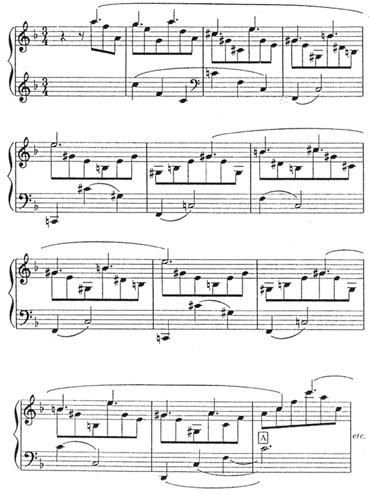


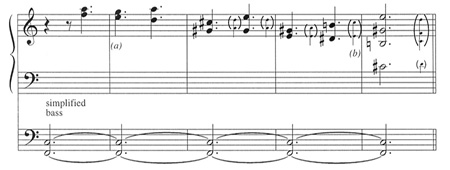
The novelty of the passage lies in the dissonance between the bass arpeggiation of an F major triad and the melodic figuration of the treble, whose apparent tonal focus is E major a semitone away. Instead of reading the passage as some sort of polytonal superimposition, Ravel neatly accounts for all the dissonant tones in the passage as either passing tones or unresolved appoggiaturas to a prolonged six-five chord on F; for the appoggiaturas he actually writes in the imaginary resolutions in parentheses. Further, by specifying that the true resolution does not occur until the chord change at letter A, Ravel interprets a de facto "middleground" level by implying the prolongation of the appoggiatura tones.15
At the same time, however, the analyst who takes Ravel's description at face value may misread or ignore the broader compositional context for the passage. While the composer's words greatly illuminate the prolongational and voice-leading aspects of the passage, they stop short of addressing the associational features, as well as the compositional motivation for this particular dissonant combination and not some other. Of course this is not to criticize Ravel for what he did not choose to talk about, but rather is intended as a cautionary to the analyst.
Example 6 takes Ravel's description as a point of departure and sketches the remainder of the Trio, up to the return of the introduction preparing the reprise.
Example 6. Valse noble #7, Trio and my analysis.
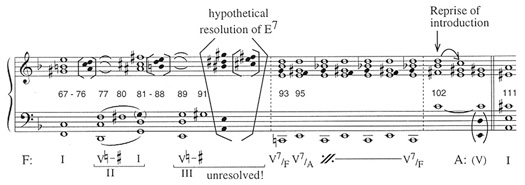
Thus F six-five gives way to G six-five with the same progression stated in sequence a step higher. Thereafter, at m. 91 the sequence is broken off at E7 which, instead of resolving to A, alternates with C7, as the dominants of A and F battle it out. At m. 102, the return of the introduction once again implies F major, which gives way as before to A major with the return of the waltz proper.
According to Ravel's comments, in the Trio the treble E major is "sublimated" to the bass arpeggiation of F major as unresolved appoggiatura. However, when the passage is considered within a broader structural context—i.e., the Trio and the flanking waltz proper—we realize that E major's "sublimation" as unresolved appoggiatura is linked to its eventual re-emergence as the structural dominant. At the same time, both the larger key scheme (A major waltz, F major trio) and the details therein (the F "dominant interjection" at the end of the waltz (mm. 63-4 and 155-6), and the C7/E7 oscillation concluding the Trio) derive from the multiple tonal implications of the introduction detailed in Example 4. In sum, while certainly not polytonal, the Trio passage is clearly polyvalent in a way that is at least obscured by Ravel's explanation; at the same time, the composer's words, when critically interrogated, help the analyst by revealing the broader structural context and motivation for the passage.
My investigation of Ravel's later music following World War I has inevitably taken me further—albeit reluctantly—into the issue of polytonality. I say reluctantly because, for many theorists, the prefix "poly" and the root word "tonality" are as oxymoronic as "jumbo shrimp" and fast-food "healthy oils." Given the explanatory power and range of application of Schenker's theory of (mono)tonality, to speak of polytonality is to risk ridicule if not downright censure. It lies well beyond the scope of this essay to thoroughly investigate this issue. Instead, I will provide what I hope is a promising point of entry by considering Ravel's remarks on polytonality in Milhaud's music, as a path into polytonality in his own music.
Of the younger generation of French composers known as "Les Six," Ravel clearly took the most interest in Milhaud. Regarding his compositional technique, Ravel writes:
. . . [In Milhaud's cantata] the "Choéphores," we soon discover that on attaining the climax of a series of utterances tragic in character, in the course of which the most sweeping use is made of all the resources of musical composition, including polytonal writing, Milhaud nevertheless reaches still profounder depths of his own artistic consciousness in a scene where a strong pathetic psalmody is accompanied only by percussion. Here it is no longer polytonality [so frequently commented upon, and often criticised] which expresses Milhaud, and yet this is one of the pages where Milhaud most profoundly reveals himself. Of similar significance is the fact that in one of his latest works, Les Malheurs d'Orphée . . . Milhaud's occasional use of polytonality is so intricately interwoven with lyric and poetic elements as to be scarcely distinguishable. . . .16
Herein Ravel reveals that, for him, polytonality as a compositional technique per se has little interest; its principal value lies in its potential for unique expressive and representational ends. We may construe this idea in broader terms by borrowing from Robert Hatten in his work on musical meaning: that is, mono- and polytonality may stand in an unmarked/marked relation to one another; or, conversely, conventional tonality may be marked within a dissonant polytonal field.17
Just as Edward T. Cone's essay "Schubert's Beethoven" sheds considerable light on the younger master's own work by detailing his take on Beethoven, so "Ravel's Milhaud" helps illuminate the older master's late style.18 Thus, in reviewing all of Ravel's post-War vocal works, virtually every passage that employs dissonant superimposition corresponds with and thereby literally represents a duality expressed in the text. An obvious example is the duet between the Wedgwood Teapot and Chinese Teacup from L'Enfant: the black Teapot sings a ragtime in the blackest key of  minor with its seven flats; the white Teacup sings nonsense pseudo-Chinese in F-pentatonic; the resultant wild superimposition of their keys is a comic highpoint in the opera.
minor with its seven flats; the white Teacup sings nonsense pseudo-Chinese in F-pentatonic; the resultant wild superimposition of their keys is a comic highpoint in the opera.
A subtler example is the little song entitled "Rêves" from 1927; Example 7 reproduces the beginning and ending.
Example 7. Ravel's setting of Fargue's "Rêves": begining and ending.
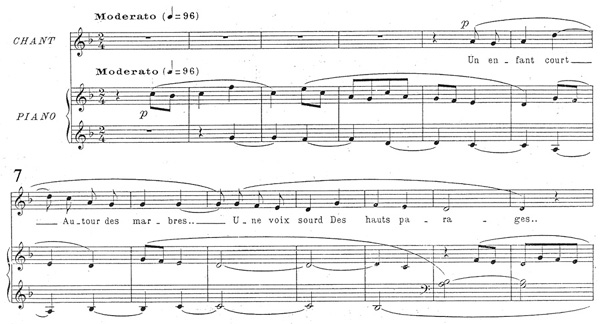
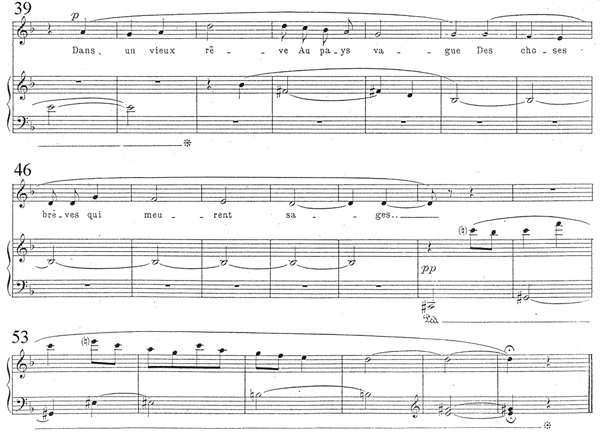
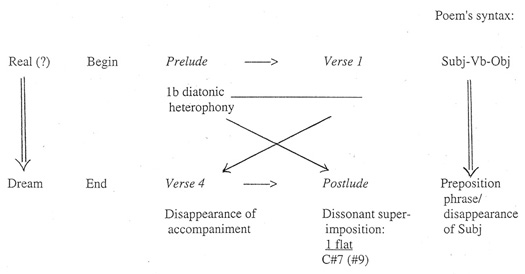
The prelude and first verse are set in the diatonic linear idiom that Ravel favored in the late works. Tonally, the music is poised between F and D as pitch centers without firmly committing to either. In the end, verse four replicates the vocal line to verse one; the original diatonic accompaniment, however, is replaced by a lone voice arpeggiating a  augmented triad, petering out on the single pitch
augmented triad, petering out on the single pitch  3 sustained for seven bars. In the postlude, the prelude music is restated an octave higher, now underpinned by an arpeggiated
3 sustained for seven bars. In the postlude, the prelude music is restated an octave higher, now underpinned by an arpeggiated  major-minor seventh with added sharp ninth; the resulting superimposition sounds maximally dissonant and quite eerie.
major-minor seventh with added sharp ninth; the resulting superimposition sounds maximally dissonant and quite eerie.
Such a radical disjunction between beginning and ending tonal domains is unparalleled in Ravel's works. Yet his choice to conclude the song in this manner makes sense in light of his remarks on Milhaud's polytonality: "Milhaud's occasional use of polytonality is so intricately interwoven with lyric and poetic elements as to be scarcely distinguishable." Let us substitute Ravel for Milhaud in the statement. Then consider the poetic elements. Semantically, the poem unfolds as a kind of journey from an opening state, poised between real and dream, to a concluding point in which the dream-state is made explicit. Syntactically, this journey unfolds as a progressive deconstruction of normative syntax: thus verse one comprises two simple statements of subject-verb-object; verse two stretches this to one statement; verse three inverts the syntax, now ordered as object-verb-subject; and verse four omits subject and verb altogether, consisting of three prepositional phrases leading off with "Dans un vieux rêve" (In an old dream). In this way, Ravel takes the poem's depiction of a dream by means of the deconstruction of normative syntax, and creates an isomorphic musical structure by deconstructing a conventional tonal syntax: i.e., by beginning diatonically and concluding polytonally.19 Had I not known Ravel's comments on Milhaud's music, it seems likely that my analysis not only would have taken a far different path, but also would not have been able to explain the central issue of the song—the motivation for the ending.
In conclusion, let us return to the issue of veracity. With a nod to my history colleague, I share his skepticism with respect to composers speaking about their music in a general sense. If, however, composers choose to comment on technical aspects of their work—i.e., to assume the role of self-analyst—then the potential for veracity increases in relation to the specificity of the observation. For the three passages considered above, Ravel is very specific in a) identifying a motive that has significant voice-leading and harmonic implications, not only for the movement in question but across other movements as well; b) identifying a chord that marks the unresolved appoggiatura as a critical factor in his harmonic language; and c) revealing text (or, more broadly, "poetic elements") as a primary motivation for employing polytonality. Each of these serves as a compositional premise within its respective movements.
Given that analytical methodologies simultaneously serve as enablers and constraints in bringing to light particular structural features and ignoring others, how does a teacher of analysis advise her/his students to choose the most appropriate one(s), especially for twentieth-century practice? Obviously the decision is an individual one. But, based on my experience in working with Ravel's music, I would suggest that the composer-as-analyst is an underutilized resource, and one that has the potential to jumpstart the analytical process at a formative stage. Composers' words, theorists' analyses—sometimes the twain shall meet.
Selected Bibliography
Chong, Eddy Kwong Mei. 2002. Extending Schenker's "Neue musikalische Theorien und Phantasien": Towards a Schenkerian Model for the Analysis of Ravel's Music. Ph.D. dissertation. Rochester, NY: Eastman School of Music.
Cohn, Richard. 1988. "Inversional Symmetry and Transpositional Combination in Bartók." Music Theory Spectrum 10: 19-42.
Cone, Edward T. 1970. "Schubert's Beethoven." The Musical Quarterly 56.4: 779-793.
Epstein, David. 1979. Beyond Orpheus. Cambridge, MA: MIT Press.
Hatten, Robert. 1994. Musical meaning in Beethoven: markedness, correlation, and interpretation. Bloomington, IN: Indiana University Press.
Jankélévitch, Vladimir. 1959. Ravel. New York: Grove Press.
Kaminsky, Peter. 2000. "Of Children, Princesses, Dreams and Isomorphisms: Text-Music Transformation in Ravel's Vocal Works." Music Analysis 19: 29-69.
Larner, Gerald. 1996. Maurice Ravel. London: Phaidon Press Limited.
Larson, Steve. 1998. "Schenkerian Analysis of Modern Jazz: Questions About Method." Music Theory Spectrum 20.2: 209-241.
Lenormand, René. 1915. A Study of Twentieth-Century Harmony. London: Joseph Williams.
Mawer, Deborah. 2000. "Ballet and the apotheosis of the dance." In The Cambridge Companion to Ravel. Edited by Deborah Mawer. Cambridge: Cambridge University Press, 140-161.
Meyer, Leonard B. 1973. Explaining Music. Berkeley, CA: University of California Press.
Orenstein, Arbie, Ed. 1989. Maurice Ravel. Lettres, Ecrits, Entretiens. Paris: Flammarion.
_______. 1975. Ravel: Man and Musician. New York: Columbia University Press.
_______, Ed. 1990. A Ravel Reader. New York: Columbia University Press.
Poe, Edgar Allan. 1986. The Raven; with The Philosophy of Composition. Boston: Northeastern University Press.
Russom, Philip Wade. 1985. A Theory of Pitch Organization for the Early Works of Maurice Ravel. Ph.D. dissertation. New Haven: Yale University.
Schachter, Carl. 1982. "Beethoven's Sketches for the First Movement of Op. 14, No. 1: A Study in Design." Journal of Music Theory 26.1: 1-22.
Schoenberg, Arnold. 1995. The musical idea and the logic, technique, and art of its presentation. Edited and translated by Patricia Carpenter and Severine Neff. New York: Columbia University Press.
An earlier version of this paper was presented as a keynote address at the Texas Society for Music Theory at Austin, Texas, February 2001.
1See Mawer 2000, 145ff.
2See Schachter 1982; and Larson 1998.
3Compositional premise is by no means a novel idea. Such constructs as Meyer's implication-realization model, Schoenberg's Grundgestalt, and Epstein's assimilation of the latter into a broader temporal framework, each interrogate compositional premise in attempting to bridge the gap between composition and analysis. Three among many significant sources include Meyer 1973; Schoenberg 1995; and Epstein 1979.
4Orenstein 1975, 128-9.
5Poe 1986.
6Larner 1996, 123-4.
7Orenstein 1975, 175-6.
8Russom 1985, 47. For a Schenkerian approach to voice leading in a number of the Valses nobles as well as other piano works by Ravel, see Chong 2002, passim. (Chong's dissertation became available subsequent to my writing this article.)
9A similar motivic overlapping takes place in Brahms's Intermezzo Op. 117 No. 3, mm. 76ff, in which the apparent two-note step figure in the alto is in reality an overlapping of the ascending third motive, stating in sequence the principal motive for the work.
10This sort of play between different tonal contexts is an important feature of Ravel's harmonic style. The "Prélude" to Le Tombeau de Couperin provides a particularly vivid example. See also the opening of "Noctuelles" from Miroirs for the prolongation of the opening sonority, there the dominant, by lower and upper neighbor chord.
11Orenstein 1975, 176.
12One well-known example for such intermovement "linkage technique" is Mozart's "Jupiter" Symphony/III, in the juncture from the Minuet to the Trio: the former ends and the latter begins with the cadential formula V7-I, supporting the treble motion from leading tone to tonic. Given the neo-Romantic style of Ravel's Valse, a more likely model is Schumann's Carnaval (of which Ravel orchestrated several movements), in particular the appropriately titled "Coquette" and "Réplique" which run together their beginning and ending gestures.
13 This may be expressed in transpositional combination terms as 3*1 -> 4*1. See Cohn 1988, passim.
14Lenormand 1915, 62-3. The analysis is also reproduced in Orenstein 1990, 519-20.
15The original French text reads "Voici maintenant le passage, avec les résolutions des appoggiatures, résolutions qui, réellement, ne s'opèrent toutes qu'a la mesure A, ou l'accord change de position." See Orenstein 1989, 394.
16Orenstein 1990, 42-3.
17Hatten 1994.
18Cone 1970, 779-793.
19For a more complete analysis, see Kaminsky 2000, 56-63.


